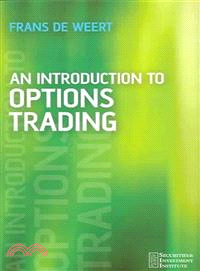| FindBook |
有 1 項符合
AN INTRODUCTION TO OPTIONS TRADING的圖書 |
 |
AN INTRODUCTION TO OPTIONS TRADING 作者:FRANS DE WEERT 出版社:JOHN WILEY & SONS,LTD 出版日期:2006-07-14 規格: / 176頁 |
| 圖書館借閱 |
| 國家圖書館 | 全國圖書書目資訊網 | 國立公共資訊圖書館 | 電子書服務平台 | MetaCat 跨館整合查詢 |
| 臺北市立圖書館 | 新北市立圖書館 | 基隆市公共圖書館 | 桃園市立圖書館 | 新竹縣公共圖書館 |
| 苗栗縣立圖書館 | 臺中市立圖書館 | 彰化縣公共圖書館 | 南投縣文化局 | 雲林縣公共圖書館 |
| 嘉義縣圖書館 | 臺南市立圖書館 | 高雄市立圖書館 | 屏東縣公共圖書館 | 宜蘭縣公共圖書館 |
| 花蓮縣文化局 | 臺東縣文化處 |
|
|
- 圖書簡介
Explaining the theory and practice of options from scratch, this book focuses on the practical side of options trading, and deals with hedging of options and how options traders earn money by doing so. Common terms in option theory are explained and readers are shown how they relate to profit. The book gives the necessary tools to deal with options in practice and it includes mathematical formulae to lift explanations from a superficial level. Throughout the book real-life examples will illustrate why investors use option structures to satisfy their needs.
- 作者簡介
Frans de Weert is mathematician by training who is currently working as an equity derivatives trader at Barclays Capital, New York. After obtaining his masters in Mathematics, specializing in probability theory and financial mathematics at the University of Utrecht, he went on to do a research degree, M.Phil, in probability theory at the University of Manchester.
After his academic career he started working as trader for Barclays Capital in London. In this role he gained experience in trading many different derivative products on European and American equities. After two and half years in London, he moved to New York to start trading derivatives on both Latin American as well as US underlyings. Frans de Weert lives in New York city. - 目次
Preface.
Acknowledgements.
Introduction
1. OPTIONS.
1.1 Examples.
1.2 American versus European options.
1.3 Terminology.
1.4 Early exercise of American options.
1.5 Payoffs.
1.6 Put-call Parity.
2. THE BLACK-SCHOLES FORMULA.
2.1 Volatility and the Black-Scholes formula.
2.2 Interest rate and the Black-Scholes formula.
2.3 Pricing American options.
3. DIVIDENDS AND THEIR EFFECT ON OPTIONS.
3.1 Forwards.
3.2 Pricing of stock options including dividends.
3.3 Pricing options in terms of the forward.
3.4 Dividend risk for options.
3.5 Synthetics.
4. IMPLIED VOLATILITY.
4.1 Example.
4.2 Strategy and implied volatility.
5. DELTA.
5.1 Delta hedging.
5.2 The most dividend sensitive options.
5.3 Exercise-ready American calls in dividend paying stocks.
6. THREE OTHER GREEKS.
6.1 Gamma.
6.2 Theta.
6.3 Vega.
7. THE PROFIT OF OPTION TRADERS.
7.1 Dynamic hedging of a long call option.
7.2 Dynamic hedging of a short call option.
7.3 Profit formula for dynamic formula.
7.4 The relationship between dynamic hedging and q.
7.5 The relationship between dynamic hedging and q when the interest rate is Strictly positive.
7.6 Conclusion.
8. OPTION GREEKS IN PRACTICE.
8.1 Interaction between Gamma and Vega.
8.2 The importance of the direction of the underlying share to the option Greeks.
8.3 Pin risk for short dated options.
8.4 The riskiest options to go short.
9. SKEW.
19.1 What is skew?
9.2 Reason for skew.
9.3 Reason for higher volatilities in falling markets.
10. SEVERAL OPTION STRATEGIES.
10.1 Call spread.
10.2 Put spread.
10.3 Collar.
10.4 Straddle.
10.5 Strangle.
11. DIFFERENT OPTION STRATEGIES AND WHY INVESTORS EXECUTE THEM.
11.1 The portfolio manager's approach to options.
11.2 Options and Corporates with cross-holdings.
11.3 Options in case of a takeover.
11.4 Risk reversals for insurance companies.
11.5 Pre-paid forwards.
11.6 Employee incentive schemes.
11.7 Share Buy-backs.
12. TWO EXOTIC OPTIONS.
12.1 The quanto option.
12.2 The composite option.
13. REPO.
13.1 A repo example.
13.2 Repo in case of a takeover.
13.3 Repo and its effect on options.
13.4 Takeover in cash and its effect on the forward.
Appendix A: Probability that an option expires in the money.
Appendix B: Variance of a composite option.
Bibliography.
Index.
|










